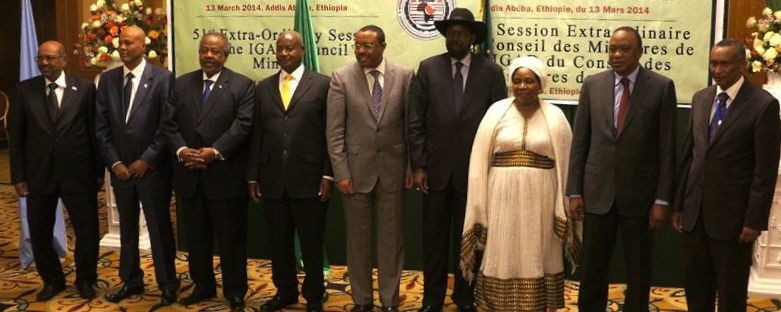East African leaders at a summit meeting in Addis Ababa today authorized deployment of a contingent of troops to help monitor and enforce the cessation of hostilities in South Sudan.
Last January the South Sudanese government and SPLM/A opposition faction signed two documents, one for the cessation of hostilities and the other on the status of political prisoners.
There have been numerous violations of the truce, but in February the two sides signed a follow-up document of ‘Implementation Modalities’ for the ceasefire, which mediators of the Inter-Governmental Authority on Development (IGAD) called a ‘significant step.’
The IGAD summit on Thursday was chaired by Ethiopian Prime Minister Hailemariam Dessalegn and attended by the heads of state of Uganda, Sudan, Djibouti, South Sudan, Kenya, and Somalia.
The East African leaders held “extensive deliberations on the overall political and security situation in South Sudan” in a closed session.
Afterwards, they issued a communiqué stating saying the summit “authorizes the prompt deployment of a Protection and Deterrent Force (PDF) from the region with a clear mandate and operational guidelines as part of the IGAD Monitoring and Verification Mechanism in South Sudan.”
Also the communiqué called on the UN Security Council an African Union to provide “all the necessary support” for mobilization of the force.
Force mandate and composition
According to the communiqué, the mission of the IGAD force would be to protect military observers themselves as well as ‘infrastructures’ in South Sudan.
IGAD called on member states and other partners to “redouble their efforts to support the robust Monitoring and Verification Mechanism and the deployment of the Protection and Deterrent Force (PDF) as part of the MVM to protect the latter and other infrastructures in South Sudan.”
IGAD chief mediator Seyoum Mesfin said that Ethiopia, Kenya, Rwanda, Burundi and possibly also Djibouti have offered to send troops to join the truce monitoring team, Bloomberg news reported today.
Seyoum said the size and cost of the force will depend on the situation in South Sudan, without providing further details. “To make it more affordable and effective, that’s why leaders have decided to make this lean, small compared to other missions,” he said.
“The main backbone of the mission is the stand-by forces that will be prepared and made ready by the troop-contributing countries in their capitals,” added Mesfin.
Another Ethiopian official explained the newly mandated contingent as “a kind of peacekeeping force.” Ethiopian Foreign Ministry Spokesperson Dina Mufti said, “This is a kind of peacekeeping force so they are going to reinforce or realize the cessation of hostilities, they’ll help that process.”
“They’ll help the monitors and the people who verify the cessation of hostilities or the ceasefire,” she told Voice of America in Addis Ababa.
Ugandan troops
It is not yet clear whether any of the Ugandan forces already in South Sudan would be absorbed into the new IGAD deterrent force or all troops would be brought in fresh from elsewhere.
Notably, the chief mediator Seyoum Mesfin omitted to mention Uganda and Sudan when listing countries that had volunteered to contribute troops to the MVM.
Moreover, the communiqué today called on the parties “to ensure the progressive withdrawal of all armed groups and all allied forces invited by either side from the theatre of operations as per the Cessation of Hostilities Agreement.”
But the same statement commended the Republic of Uganda for “securing vital installations in South Sudan.” Also it added that all IGAD Member States may participate as ‘observers’ at the on-going negotiations and in the MVM.
Photo: Leaders at the 25th Extraordinary Summit of the IGAD Heads of States and Government in Addis Ababa, 13 March 2014 (IGAD Secretariat)




